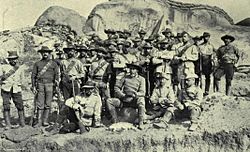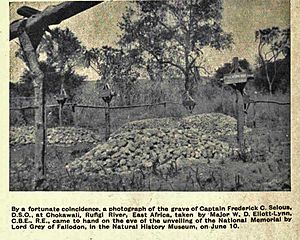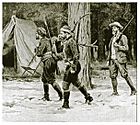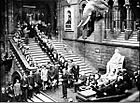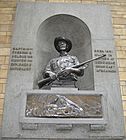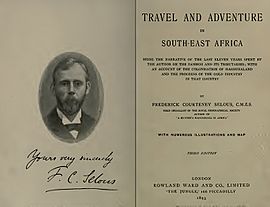Frederick Selous facts for kids
Quick facts for kids
Frederick Selous
|
|
|---|---|
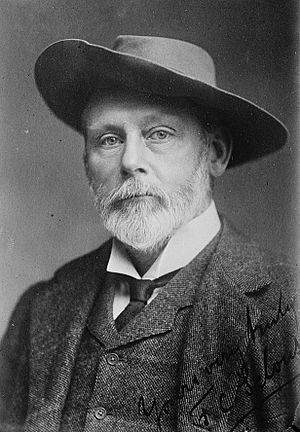
Selous circa 1911
|
|
| Birth name | Frederick Courteney Selous |
| Born | 31 December 1851 London, England |
| Died | January 4, 1917 (aged 65) Behobeho, German East Africa (now the Selous Game Reserve in southeastern Tanzania) |
| Allegiance | |
| Rank | Captain |
| Commands held | Bulawayo Field Force, Matabeleland; 25th Royal Fusiliers, East Africa |
| Battles/wars | First Matabele War, Second Matabele War, World War I: --East African Campaign |
| Awards | Founder's Medal of the Royal Geographical Society, British South Africa Company Medal Distinguished Service Order |
| Other work | Famous African hunter and explorer, conservationist, writer |
Frederick Courteney Selous, also known as DSO (born December 31, 1851 – died January 4, 1917), was a famous British explorer, soldier, professional hunter, and conservationist. He was well-known for his adventures in Southeast Africa. His exciting real-life stories even inspired the writer H. Rider Haggard to create the fictional character Allan Quatermain. Selous was good friends with important people like Theodore Roosevelt, Cecil Rhodes, and Frederick Russell Burnham. He was one of the most respected big game hunters of his time.
Contents
Early Life and Adventures
Frederick Courteney Selous was born in London, England, on December 31, 1851. He was one of five children in a wealthy family. His father was the Chairman of the London Stock Exchange, and his mother was a published poet. Frederick had a strong love for nature and wildlife from a young age, just like his brother, Edmund Selous, who became a famous expert on birds.
When he was 42, Selous settled in England and married Marie Catherine Gladys Maddy. They had three sons together.
Growing Up with a Love for Nature
From a very young age, Selous was fascinated by stories of explorers and their adventures. He started collecting bird eggs and butterflies and loved studying nature. His schoolmaster once found him sleeping on the floor and asked why. Selous replied, "Well, you see, one day I am going to be a hunter in Africa and I am just hardening myself to sleep on the ground."
When he was 17, Selous survived a terrible ice accident in Regent's Park, where many people drowned. He managed to crawl to safety on broken ice.
He went to school in England and then in Germany and Austria. His parents hoped he would become a doctor. However, his passion for wildlife led him to study wild animals in their natural homes. He was greatly inspired by books about African exploration and hunting, especially by Dr. David Livingstone.
Exploring Africa's Wild Lands
At 19, Selous traveled to South Africa. By early 1872, he reached Matabeleland. There, he received permission from Lobengula, the King of the Ndebele people, to hunt anywhere in his lands.
From then until 1890, Selous spent most of his time hunting and exploring unknown parts of Africa. He hunted African elephants and collected animal specimens for museums. His journeys helped people learn a lot about the country now known as Zimbabwe. He also learned much about different cultures and always got along well with the local chiefs and tribes.
In 1890, Cecil Rhodes asked Selous to work for the British South Africa Company. Selous became a guide for an expedition that traveled over 400 miles through forests, mountains, and swamps. He safely led the group to their destination in Mashonaland. In 1892, he received the Founder's Medal from the Royal Geographical Society for his extensive explorations.
Military Adventures
Fighting in Rhodesia and World War I
Selous returned to Africa to fight in the First Matabele War in 1893. He was injured during a push towards Bulawayo. During this time, he met another scout, Frederick Russell Burnham.
Selous went back to England, got married, and then returned to Africa with his wife in 1896. They settled in Matabeleland. When the Second Matabele War began, Selous played a big part in the fighting. He led a group in the Bulawayo Field Force. He also wrote a book about the war called Sunshine and Storm in Rhodesia. During this war, he fought alongside Robert Baden-Powell, who later founded the Scout movement.
In World War I, even though he was 64 years old, Selous joined the British Army again. He fought against German forces in the East Africa Campaign. In 1915, he was promoted to Captain. In 1916, he received the Distinguished Service Order for his bravery and leadership. The award praised his "magnificent example to all ranks."
His Final Battle and Legacy
On January 4, 1917, Selous was fighting in the bush near the Rufiji River in Africa. He was trying to find the enemy when a German sniper shot him in the head, killing him instantly.
When American President Theodore Roosevelt heard the news, he wrote about Selous. He said Selous lived an amazing life, full of adventure and exploration. Roosevelt felt Selous died exactly as he should have, fighting bravely for his country.
Selous was buried under a tamarind tree near where he died. His grave is in what is now the Selous Game Reserve in Tanzania. Exactly one year later, his son, Frederick Hatherley Bruce, who was a pilot, was also killed in battle in Belgium.
Selous: Hunter, Naturalist, and Conservationist
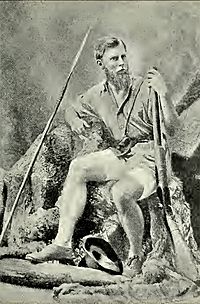
A Famous Hunter
Selous is remembered for his strong connections with people like Theodore Roosevelt and Cecil Rhodes. He is also known for his military achievements and the books he wrote. But most of all, he is famous as one of the world's most respected hunters. He hunted big game in southern Africa and other wild places around the world.
Stories from his youth show his adventurous spirit. Once, when he was 18 in Germany, he knocked out a game warden who tried to stop him from stealing buzzard eggs. He had to leave the country quickly to avoid jail. Later, in Austria, he hunted big game for the first time, shooting two chamois.
On September 4, 1871, at age 19, he left England with £400. He wanted to become a professional elephant hunter. By the time he was 25, he was one of the most successful ivory hunters in South Africa.
Selous traveled to hunt big game in many places. These included Europe (like Germany and Scotland), Asia (like Turkey and Iran), and North America (like Wyoming and Alaska). He also hunted across Africa, from South Africa to central Sudan. He collected almost every type of medium and large African mammal.
In 1902, Selous became a member of the Boone and Crockett Club. This is a wildlife conservation group started by Theodore Roosevelt.
In 1909–1910, Selous joined former American President Theodore Roosevelt on his famous African safari. Selous helped organize the trip, but he did not lead Roosevelt's expedition. Roosevelt wrote about Selous, calling him "the last of the big game hunters of Southern Africa."
In 1909, Selous helped start the Shikar Club, a group for big-game hunters. They met regularly in London.
Selous was also an expert with firearms. Early in his hunting career, he used a very large four bore muzzleloader rifle to hunt elephants. Later, he used more modern rifles. He was known for his modesty, often saying he was just an "ordinary marksman." Still, he is seen as an iconic rifleman. Some gunmakers even named their top safari rifles after him.
A Naturalist and Collector
Many of the animals Selous hunted ended up in museums and natural history collections. The Natural History Museum in London has a large "Selous Collection." It includes 524 mammals from three continents, all hunted by him, including 19 lions. Even during World War I, he would collect butterfly specimens in the evenings for the museum. In total, he donated over five thousand plant and animal specimens to the British Museum. A bronze statue of him stands in the Main Hall of the Natural History Museum today.
In 1896, a British zoologist named a new African animal, the Selous mongoose, in his honor. A type of African Sitatunga antelope also carries his name.
A Champion for Conservation
Over time, Selous noticed that European hunters were causing a big drop in the number of animals in Africa. In 1881, he said that elephants were becoming much rarer south of the Zambezi River.
This made Selous and other hunters realize the importance of protecting wildlife. They became strong supporters of animal conservation. Because of their efforts, colonial governments eventually created laws to control hunting and set up game reserves. The goal was to prevent animals from disappearing completely and to save them for the future.
The Selous Game Reserve in southeastern Tanzania is a large hunting reserve named after him. It was created in 1922 and covers a huge area. It is a UNESCO World Heritage Site because of its diverse wildlife and untouched nature.
Selous: The Man and His Image
A Character in Books and Shows
Frederick Courteney Selous is often seen as a classic example of a proper English gentleman from the Victorian period. His amazing real-life adventures inspired popular fictional characters like Allan Quatermain. He was a modest and strong person throughout his life. Selous himself was featured in the "Young Indiana Jones" and "Rhodes" TV series. He is remembered as a mix of a gentleman officer and a wild adventurer.
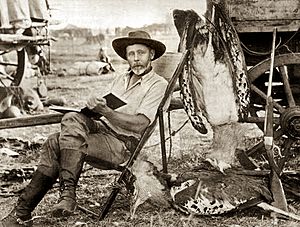
His Appearance and Personality
Selous was excellent at many sports, including cricket, rugby, cycling, swimming, and tennis. He loved being outdoors and became very strong and fit from trekking and hunting. He was also a skilled horse rider. African locals called him the "best white runner" because of his endurance.
Even when he was almost sixty years old, he still rode his bicycle for 100-mile races. His friend and biographer, J. G. Millais, wrote that Selous loved cricket the most and played regularly until 1915.
Millais also described Selous's "wonderful eyes, as clear and as blue as the summer sea." People noticed his eyes, which seemed to show his experience as a hunter and explorer. Selous had a strong presence and was loved by his friends. He always had a full beard and wore his signature hats, making him easily recognizable.
Television Accounts
- The Young Indiana Jones Chronicles (TV-Series, 1992–1993) ; played by Paul Freeman
- British East Africa, September 1909 (1992)
- Young Indiana Jones and the Phantom Train of Doom, German East Africa, November 1916 (1993)
- Rhodes (TV Mini-Series, 1996) ; played by Paul Slabolepszy
Gallery of additional images
-
Selous returning from stag hunt in Turkey, book illustration, 1908.
-
Close up picture of the Selous Memorial in the wall in the main hall of the Natural History Museum
-
Skull of a record white rhino, shot by Selous in Mashonaland, 1880.
Books by Frederick Courteney Selous
- A Hunter's Wanderings in Africa (1881)
- Travel and Adventure in South-East Africa (1893)
- Sunshine & Storm in Rhodesia (1896)
- Sport & Travel East and West (1900)
- Living Animals of the World (1902)
- Newfoundland Guide Book (1905)
- Recent Hunting Trips in British North America (1907)
- African Nature Notes and Reminiscences (1908)
- Africa's Greatest Hunter: the Lost Writings of Frederick C. Selous (1998)
Selous also wrote the introduction for The Man-Eaters of Tsavo (1907), a famous story about man-eating lions. He also wrote many articles for journals like The Geographical Journal.
- Books about Frederick Courteney Selous
- The Life of Frederick Courtenay Selous, D.S.O. by John Guille Millais (1919)
- Catalogue of the Selous Collection of Big Game in the British Museum (Natural History) by J. G. Dollman (1921)
- Frederick C. Selous, A Hunting Legend by Dr. James A. Casada (2000)
See also
 In Spanish: Frederick Selous para niños
In Spanish: Frederick Selous para niños


